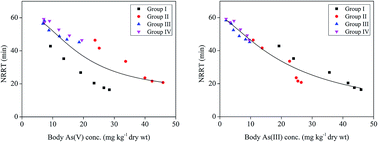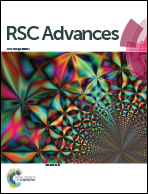Lysosomal membrane response of the earthworm, Eisenia fetida, to arsenic species exposure in OECD soil
Abstract
Different arsenic species always coexist in environmental soils and show various degrees of toxicity. However, the biochemical impact on earthworms under exposure to different arsenic species remains unknown. In this study, earthworms (Eisenia fetida) were exposed to Organization for Economic Cooperation and Development (OECD) artificial soil contaminated by arsenite [As(III)], arsenate [As(V)], monomethylarsonate (MMA) and dimethylarsinate (DMA) respectively for 70 days. Aimed at the comparison of toxicity, the exposure concentrations of the four arsenic species were set at one-tenth of 14 d-LC50. A biomarker of the lysosomal membrane stability, measured by neutral-red retention time (NRRT), was evaluated for toxicity assessment of the four arsenic species. Furthermore, the contents of total arsenic and arsenic species were analyzed in earthworms in order to not only evaluate the dose–response relationship between arsenic accumulation and NRRTs, but also to observe the effect of arsenic biotransformation on subcellular level toxicity. The results showed that there were clear dose–response relationships between the body burden of inorganic arsenic species and NRRTs, while the correlation coefficient between NRRT and As(III) was higher than that between NRRT and As(V). The NRRT assay results suggested that the toxicity of the four arsenic species was ranked as As(III) > As(V) > MMA > DMA. Therefore, arsenic speciation should be conducted in order to obtain accurate results during environmental assessment programs. Despite the low toxicity, the two organic arsenics could be transformed to highly toxic inorganic arsenic species through the demethylation process, after which adverse effects observable at the subcellular level in earthworms could thus be induced. Highly toxic inorganic arsenics were methylated and converted to less toxic organic species before excretion. Considered as the biotransformation pathway of arsenic in earthworms, the process mentioned above was validated in this study. Lysosomal membrane stability is a sufficiently sensitive biomarker for toxicity assessment of inorganic arsenic pollution, and especially suitable for the monitoring of As(III) species.


 Please wait while we load your content...
Please wait while we load your content...